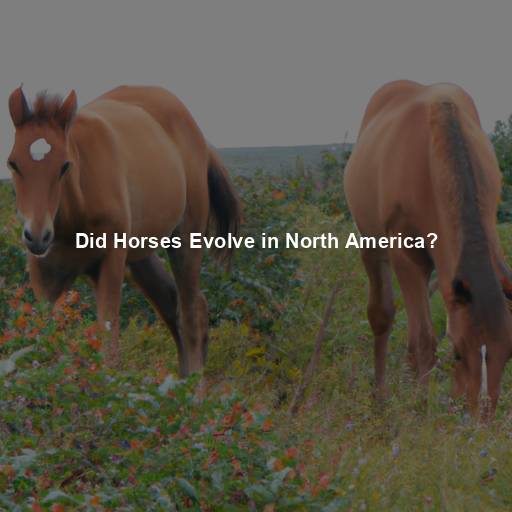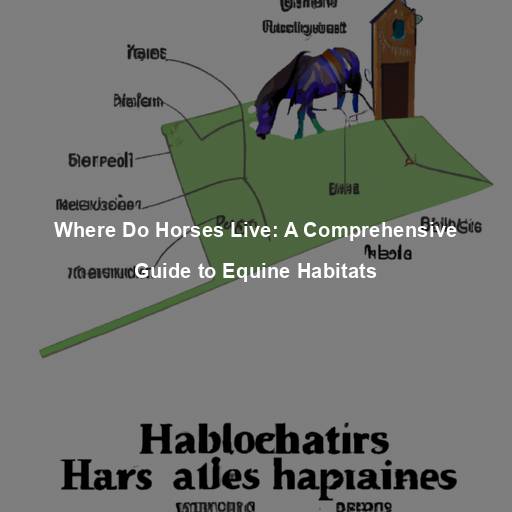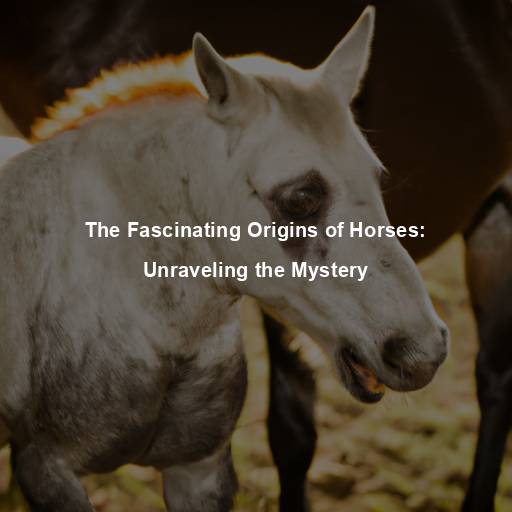Did Horses Evolve in North America?
Last Updated on November 9, 2023 by Evan
Contents [hide]
- 1 Understanding the Origins of Horses
- 1.1 The Journey Begins: The Dawn Horse
- 1.2 A Global Distribution
- 1.3 North America: The Birthplace of the Modern Horse
- 1.4 The Great American Interchange
- 1.5 Debunking the Misconceptions: Horses and Native Americans
- 1.6 The Changing Landscape
- 1.7 Adaptation to Open Grasslands
- 1.8 Parallel Evolution in Other Continents
- 2 Unraveling the Fossil Record: A Window into the Past
- 3 The Future of Horses: Conservation and Welfare
- 4 The Spirit of the Horse: Symbolism and Cultural Significance
- 5 The Future of Horses: Conservation and Ethical Considerations
- 6 FAQs: Did Horses Evolve in North America
- 6.1 What is the origin of horses?
- 6.2 Did horses go extinct in North America?
- 6.3 How did horses make their way back to North America?
- 6.4 Are modern-day North American horses descendants of the original horse species?
- 6.5 Are there any wild horse populations in North America?
- 6.6 Are there any living horse species native to North America?
Understanding the Origins of Horses
Horses have always held a captivating aura, entwined with our very existence. Their majestic presence has impacted various aspects of our lives, from being our companions in travel and labor, to igniting our passions for sports and leisure. But amidst this captivating enchantment, a swirling question persists – where did these magnificent creatures originate? The origins of horses, a topic that has long perplexed scientists, has sparked impassioned debates and captured the imagination of many.
The Journey Begins: The Dawn Horse
To understand the origins of horses, we must travel back in time to the Eocene epoch, approximately 56 to 34 million years ago. It is during this period that the earliest known ancestor of the modern horse, known as the “dawn horse” or Hyracotherium, roamed the Earth. Fossil evidence suggests that these small mammals were about the size of a dog and had four toes on their front feet and three on their hind feet.
A Global Distribution
In the fascinating era known as the Eocene epoch, the awe-inspiring journey of horses traversed landscapes beyond our wildest imagination. Astonishing fossil records offer glimpses into a time when the illustrious horse family, the very embodiment of grace and power, gallivanted across the globe. From the untamed wilderness of North America to the ancient realms of Europe and Asia, these remarkable creatures left their hoofprints in diverse corners of our planet, defying the boundaries of continents in their bewildering evolution. Prepare to be captivated by the enigmatic chapters of equine history as we uncover the astonishing truth behind the boundless dispersion of these majestic beings.
North America: The Birthplace of the Modern Horse
Throughout the captivating Eocene epoch, the majestic presence of horses knew no boundaries as they traversed the globe. Yet amidst this expansive journey, it was the enigmatic realm of North America that unveiled a profound narrative in the evolution of these magnificent creatures. In the great tapestry of time, fossil discoveries within North America serve as elusive keys, unlocking the secrets of horse metamorphosis that unfolded over countless millennia, leaving us in a state of awe and wonder.
The Evolutionary Path: From Hyracotherium to Equus
The horse’s incredible transformation throughout its evolutionary history never ceases to astonish. From its humble beginnings as the dawn horse, to the magnificent equine genus Equus that we know today, the journey is marked by a series of perplexing changes. Fossils discovered in North America unveil a captivating narrative of gradual skeletal modifications, such as the elongation of limbs and the reduction in toe count, all culminating in the emergence of the distinct long face and grinding teeth that define the modern-day horse.
The Great American Interchange
The evolutionary history of horses in North America took an intriguing turn during the Pleistocene epoch, approximately 2.6 million to 11,700 years ago. This period marked the time when the Great American Interchange occurred, leading to the migration of various species between North and South America. While horses were already present in North America, they disappeared from the continent around 10,000 years ago. Interestingly, horses were reintroduced to North America much later, with the arrival of Spanish explorers in the 16th century.
Debunking the Misconceptions: Horses and Native Americans
There’s a fascinating twist to the story of horses in North America that defies common beliefs. Contrary to popular misconception, these majestic creatures were not originally native to the land, and it was the Spanish colonizers who brought them back after their initial disappearance. The reintroduction of horses by the colonizers had a mind-boggling effect on the Native American tribes, forever altering their cultural landscape. Suddenly, these magnificent animals became vital for transportation, hunting, and even warfare, reshaping the very fabric of Native American societies in ways no one could have predicted.
The Changing Landscape
As we explore the fascinating journey of horses throughout time, it becomes apparent that the intricate dance between climate and their evolution has left us more perplexed than ever. Venturing back to the Eocene epoch, an era drenched in a climate that differs greatly from our modern world, we find North America draped in lush forests and sprawling wetlands. In this bewildering landscape, the early horse ancestors found a sanctuary where they could thrive and adapt to the ever-changing natural rhythms.
Adaptation to Open Grasslands
Around 20 million years ago, North America experienced a drastic change in its climate, leading to the expansion of open grasslands. This shift created new ecological niches, and horses began to adapt to this changing landscape. The elongation of their limbs, the reduction in the number of toes, and the development of specialized grinding teeth were all adaptations that allowed horses to thrive in the grassland environment.
Parallel Evolution in Other Continents
The mesmerizing story of horse evolution transcends borders and continents, captivating minds with its enigmatic twists and turns. As North America beheld the graceful dance of equine transformation, an enigmatic tale of parallel evolution unfolded in the distant lands of Eurasia. Here, the enigmatic Dinohippus emerged, a testament to the perplexing forces of nature that shaped the destiny of these majestic creatures across vast oceans. This remarkable parallel evolution allows us to glimpse into a world where ecological pressures and opportunities harmoniously weaved their intricate tapestry, and where the enigma of equine existence transcended the boundaries of continents.
Unraveling the Fossil Record: A Window into the Past
Fossil Discoveries in North America
Unraveling the enigmatic timeline of horse evolution is an enthralling endeavor, with the fossil record serving as a bewildering portal to the past. North America, a veritable cornucopia of horse fossils, has bestowed upon scientists a remarkable tapestry of knowledge concerning the bygone saga of these majestic beings. From the diminutive Mesohippus to the grandeur of Equus, an array of horse species have emerged from the depths of the continent’s unearthed treasures, each fragment a perplexing puzzle piece in the enthralling narrative of equine ancestry.
The Hagerman Horse: A Remarkable Discovery
Prepare to be captivated by the astonishing tale of the Hagerman horse, a captivating creature who once roamed the vast landscapes of North America. Unearthed in the breathtaking region of Hagerman, Idaho, this magnificent equine specimen, scientifically christened Equus simplicidens, takes us on a perplexing journey through time. With its petite frame and graceful silhouette, this prehistoric marvel reveals its remarkable ability to adapt to the grassy plains of yesteryear, leaving us astounded by its evolutionary prowess. Join us as we unravel the secrets of this elusive beauty and delve deeper into the mysterious world of ancient equines.
The Horse-Human Connection: A Journey Through Time
The bond between horses and humans stretches back thousands of years. From their use in agricultural work to their role in warfare and transportation, horses have been indispensable companions to humans throughout history. The domestication of horses revolutionized human societies, enabling the exploration and conquest of new territories, as well as facilitating trade and communication.
Modern Horse Breeds: A Testament to Human Influence
Over the centuries, humans have selectively bred horses for various purposes, resulting in the diverse array of horse breeds we see today. Each breed possesses unique characteristics and traits that make them well-suited for specific activities such as racing, jumping, or working on farms. From the elegant Arabian to the sturdy Clydesdale, the vast array of horse breeds is a testament to the enduring bond between humans and horses.
The Future of Horses: Conservation and Welfare
The Plight of Wild Horses
The world of horses is a complex tapestry where the paths of domestication and wildness intertwine, but the divergence in their fates is as perplexing as it is fascinating. While our equine companions flourish under our watchful eyes, their untamed brethren struggle to navigate an ever-changing landscape fraught with obstacles. Iconic horses like the majestic mustangs of North America find themselves caught in a web of challenges – their habitats shrinking, their existence threatened by the encroachment of livestock, and the intricacies of managing their delicate populations. As custodians of this delicate balance, the urgency to undertake robust conservation initiatives becomes indisputable, safeguarding not only these magnificent creatures but also the integrity of their natural homes.
Equine Welfare: A Priority for Responsible Horse Ownership
As caretakers of these magnificent animals, it is our responsibility to prioritize their welfare. Providing proper nutrition, veterinary care, and appropriate living conditions are crucial aspects of responsible horse ownership. Additionally, promoting ethical training methods and discouraging practices that cause physical or psychological harm to horses is essential for their well-being.
The Horse as a Tool of Progress
It’s absolutely mind-boggling to think about how the taming of horses rocked the boat for our ancestors, reshaping the entire trajectory of human existence. I mean, just picture it: these magnificent creatures, with their raw power, lightning-fast legs, and unyielding stamina, became nothing short of life-changing. Suddenly, people could transport goods over vast distances, cultivate land with newfound efficiency, and even wage war in a whole new league of warfare. This transformative leap in mobility not only fueled unprecedented trade exchanges, but also fostered the birth and growth of remarkable civilizations, enabling the beautiful dance of ideas and cultures to flourish like never before.
Horses in Agriculture and Industry
Throughout history, horses have been steadfast companions on the journey of human progress. Their unwavering presence in the realm of agriculture speaks volumes about their importance in shaping our world. From their tireless efforts in powering early machinery to the indescribable bond formed between man and horse, their impact cannot be diminished. As the wheels of time turned and machines became the norm, horses gracefully stepped aside, leaving behind a legacy adorned with awe and admiration.
Horses in Warfare and Exploration
Throughout history, horses have been instrumental in warfare and exploration. Mounted warriors, such as knights and cavalry soldiers, relied on horses for mobility and increased striking power. Horses enabled the rapid movement of armies and the conquest of new territories. Explorers and pioneers also heavily relied on horses for transportation, enabling them to venture into uncharted lands.
The Role of Horses in Sports and Recreation
Beyond their utilitarian roles, horses have also been a source of entertainment and recreation. Equestrian sports, such as horse racing, show jumping, and dressage, have captivated audiences for centuries. The grace, beauty, and athleticism of horses have made them ideal companions for leisurely activities such as trail riding, horseback camping, and therapeutic riding programs.
The Spirit of the Horse: Symbolism and Cultural Significance
Horses in Mythology and Symbolism
Horses have held a special place in human mythology and symbolism across cultures. In many mythological traditions, horses are associated with power, freedom, and the divine. They are often depicted as symbols of strength, grace, and nobility. From the winged Pegasus in Greek mythology to the mystical unicorns of folklore, horses have fascinated and inspired our imaginations.
Horses in Art and Literature
Throughout the annals of history, the awe-inspiring allure and breathtaking splendor inherent in the essence of horses have transcended time and space, leaving an indelible imprint on the world of art and literature. Across the vast expanse of human creativity, from ancient cave walls adorned with enigmatic depictions to the birth of unmistakable Renaissance masterpieces, these majestic creatures have held an unyielding grip on the imagination of artists. Moreover, within the realms of storytelling, they have galloped their way into the central fabric of epic sagas and cherished children’s narratives, infusing the hearts of readers with an irresistible sense of curiosity, excitement, and bewilderment at the enigmatic nature of these incredible beings.
The Horse in Cultural Traditions
Throughout history, horses have undeniably left their hoofprints on the cultural tapestry of diverse societies worldwide. From the resplendent spectacles of European equestrian extravaganzas to the spirited galas honoring these majestic creatures in Asia, it becomes abundantly clear that horses hold a cherished place in the hearts and rituals of countless cultures. The vibrant allure of horse-centric festivities, exemplified by grand processions during the Chinese New Year or the awe-inspiring displays of the Spanish Riding School, serves as a testament to the enduring symbolism and cultural resonance embodied by these graceful equines. As time marches on, the bewildering connection between humans and horses continues to deepen, blazing a trail of bewilderment and fascination for all those captivated by the enigmatic bond between man and beast.
The Future of Horses: Conservation and Ethical Considerations
Preserving Equine Genetic Diversity
In an era where horse populations confront multifaceted challenges like dwindling habitats and detrimental genetic patterns, the urgency to protect their diverse and distinctive genetic makeup intensifies. By implementing genetic conservation initiatives, these programs strive not only to preserve the distinctive attributes and characteristics unique to each horse breed, but also to secure their survival and fortitude in the face of adversity. As we navigate the perplexing landscapes of horse conservation, the pursuit of long-term sustainable strategies is paramount.
Ethical Considerations in Horse Care and Use
In this rapidly changing world, where our knowledge of animal welfare constantly expands, it becomes increasingly imperative to ponder over the profound moral consequences surrounding the treatment and utilization of our noble equine companions. Becoming a conscientious horse owner entails more than just fulfilling their basic needs like nutrition, veterinary care, and an adequate living environment. It involves delving deep into the intricacies of their physical and mental well-being, acknowledging their intrinsic abilities, and opting for humane training techniques that align with their natural instincts and fundamental necessities.
Equine-Assisted Therapy and Education
Horses have also proven to be valuable partners in therapeutic and educational programs. Equine-assisted therapy has shown positive results in treating individuals with physical, emotional, and cognitive challenges. Furthermore, equine-assisted learning programs utilize horses as teaching tools, fostering personal growth, and facilitating the development of life skills.
FAQs: Did Horses Evolve in North America
What is the origin of horses?
Horses, as we know them today, originally evolved in North America. The oldest known horse ancestors originated on this continent, approximately 55 million years ago, during the Eocene epoch. These early horse ancestors were small in size, about the size of a dog, and had several toes instead of hooves. Over time, they diversified and spread to other continents.
Did horses go extinct in North America?
In a captivating twist of fate, the majestic horses that once gracefully roamed the vast landscapes of North America have become but a mere echo of ancient times. An enigma shrouded in perplexity, their disappearance remains an unsolved puzzle that has puzzled researchers for centuries. With the passage of millennia, the precise confluence of environmental shifts and the strategic hand of human hunters continue to bewilder those seeking answers. The fading hoofprints of these extraordinary creatures serve as a poignant reminder of a forgotten era, forever etching their enigmatic legacy in the annals of history.
How did horses make their way back to North America?
Horses were reintroduced to North America by European explorers and settlers during the 15th and 16th centuries. These introduced horses were descendants of domesticated horses that originated in Eurasia. They spread rapidly throughout North America and played a significant role in the subsequent colonization and development of the continent.
Are modern-day North American horses descendants of the original horse species?
Contrary to popular belief, the magnificent horses roaming North America are not direct descendants of the native species that flourished here centuries ago. Instead, they owe their heritage to the gallant equines introduced by intrepid European settlers. Over time, these equine pioneers intertwined with a tapestry of domesticated and untamed horses, resulting in a tapestry of diverse breeds and populations that captivate our senses today, leaving us in perpetual awe and intrigue.
Are there any wild horse populations in North America?
North America boasts a captivating secret befitting of its vast landscapes – the enchanting existence of wild horse populations. These majestic creatures trace their lineage back to their once-domesticated brethren, who inadvertently embarked on untamed adventures. Witnessing this unfolding chapter of history, the mustang population emerges as a shining example, galloping freely through the untamed terrain of the western United States. The dynamic interplay of their evolution and their ancestral imprints continues to captivate, while dedicated endeavors thrive to safeguard and regulate these enigmatic equine communities, ensuring their vibrant survival and cherished welfare.
Are there any living horse species native to North America?
No, there are no living horse species native to North America. However, there are several other species of wild equids, such as zebras and wild asses, that are native to other parts of the world. The horse species that evolved in North America became extinct, and the horses we see today are descendants of reintroduced and domesticated horses.







